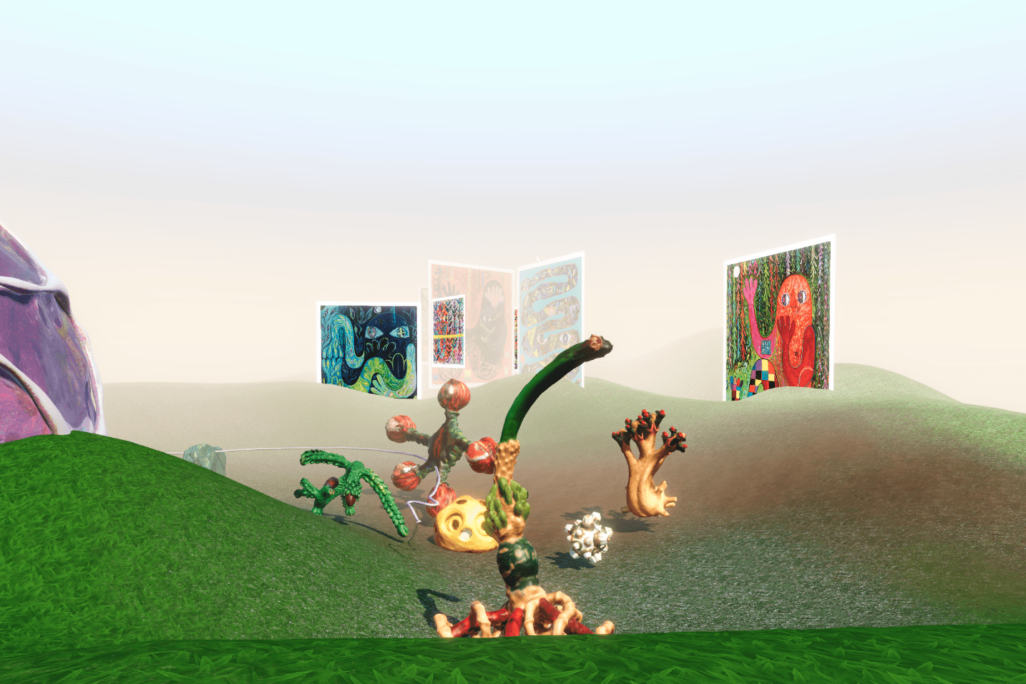About the Digital Exhibition
Human activity continues to threaten Earth’s biodiversity and shared resources. How are artists responding across the world, across mediums, and across realities?
Echoes from the Future is an entirely virtual exhibition! You can visit this exhibition online using a Windows or Mac computer. Or, you can view this exhibition on a Meta Quest 2 virtual reality headset. Between June 29th and September 27th, visit this website to download the program for this virtual exhibition. You can also visit the MacKenzie Art Gallery to view this exhibition in virtual reality from August 1st to September 17th.
When you enter the exhibition, there’s a chance that you’ll see other people visiting the same online space. They will be represented by a jellyfish-like avatar. You can even speak to other people in the exhibition by using a microphone. Like in any online space, please be polite!
Echoes from the Future is set in a bare, hilly landscape inspired by the picture on Windows XP’s desktop. This exhibition makes current environmental issues visible in virtual reality. It contains diverse digital artworks meant to preserve nature, reveal environmental devastation, and imagine future life forms.
Important Words
Biodiversity: the number of different species of animals, plants, fungi, and even single-celled living things exist in one space.
Virtual: existing digitally on a computer.
Avatar: an image used to represent you in a digital space.
Adapting: changing to fit a new situation.
Evolving: when a species slowly changes over generations. Usually these changes make the species more complex and help them survive.
Speculated: guessed or imagined. Speculative means something is based on a guess.
About the Curator and Artists
This exhibition was curated by Tina Sauerlaender. Tina is a curator, art historian, speaker and writer from Berlin. Her areas of interest are digital and virtual reality art. Tina helped create peer to space, an organization that makes digital art exhibitions with artists around the world. Tina also helped create Radiance, an international platform for researching and improving virtual reality art experiences.
Echoes from the Future includes artworks by seven international artists: Aviv Benn (Israel/United Kingdom) Laura Colmenares Guerra (Columbia/Belgium) Reiner Maria Matysik (Germany) Sarah Oh-Mock (Germany) Bianca Shonee Arroyo-Kreimes (Canada) Sabrina Ratté (Canada) and Tamiko Thiel (United States/Germany).
Things to Think About
- Living things are always slowly adapting and evolving to suit their environment. How do the artists in Echoes from the Future show plants and animals evolving and adapting to fit into a virtual world?
- What were the artists able to do in this virtual space that couldn’t happen in-person at an art gallery?
Studio Activity
What do you think life will look like in the future? Or what do you think life would be like in a virtual world? Design a plant or animal that could live in a futuristic digital space. Try to think about the ways your creature or plant might adapt to this new space, or the changes that the future might bring. You can also think about how you might provide care for this living thing in a virtual space.
Supplies:
- Drawing supplies of your choice, or
- A computer/tablet/phone or other digital artmaking tool
Instructions:
- Visit the online exhibition Echoes from the Future. Think about how the artists speculated what life would be like in a virtual space.
- Imagine a virtual space that your plant or animal will live in. Think about the features of that space. What does your virtual space look like, feel like, and sound like? What exists in this imaginary digital space?
- Draw, either by hand or digitally, a creature or plant that could live in that imagined virtual space. You could also draw the virtual space in the background. Try to show traits that your plant or animal would have to help it survive in this space. Think about how it would have adapted and evolved, and how it would need to be cared for to survive.

